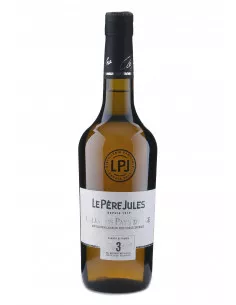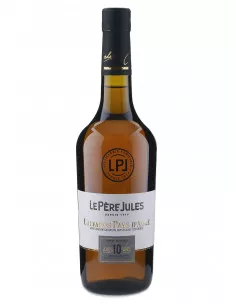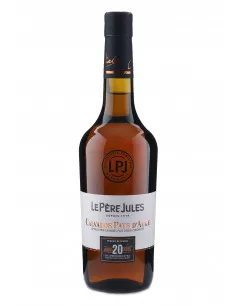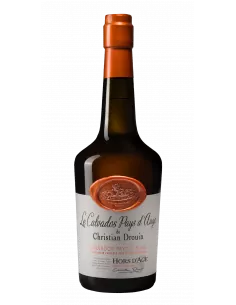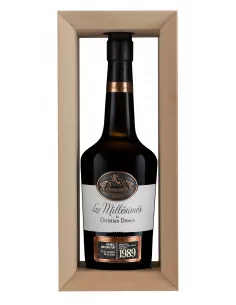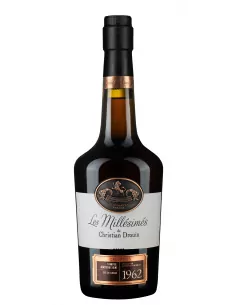
What is Calvados
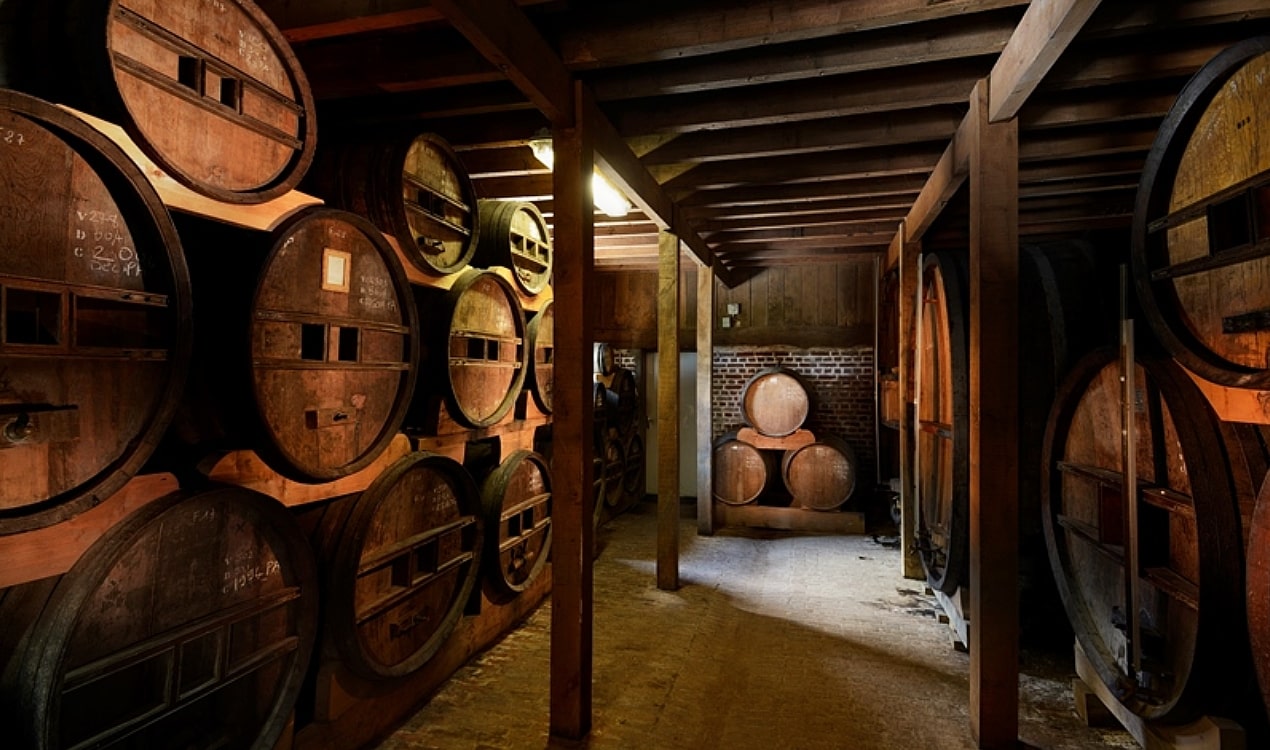
What is Calvados?
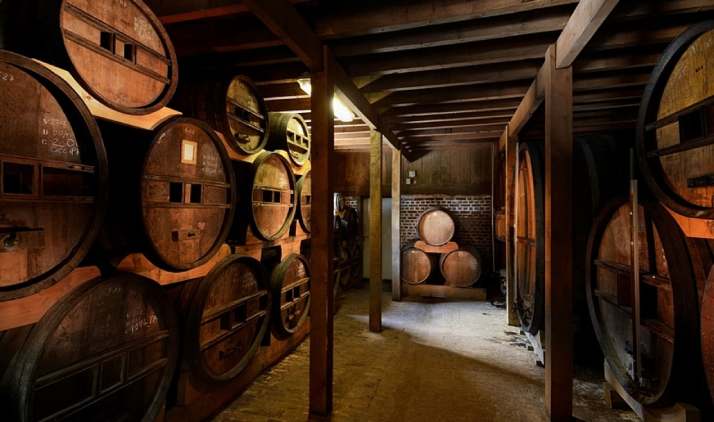
What is Calvados?
We know our name is Cognac Expert, so you may be wondering why on earth we are even asking the question, what is Calvados? But the simple fact of the matter is, France has too many talents when it comes to creating excellent spirits and we thought it unfair to deprive our collection of Cognac connoisseurs from some of the other delights produced in this multifaceted country.
- Calvados: The Place
- The apples (and pears)
- Making cider
- Distillation
- Aging
- Blending and reduction
- Age classifications
- How to enjoy
- Christian Drouin
- Calvados vs. Cognac
- Calvados products in our shop
- FAQ
Now, back to the question, what even is Calvados? Well, the simple answer is, much like Cognac, it is a variety of Brandy. Calvados, however, originates from apples (and sometimes pears) rather than grapes and is strictly produced within the Normandy region, in North West France. Here at Cognac Expert though, we don’t just provide the simple answer, otherwise we wouldn’t be experts now, would we? So prepare yourself for a deep dive into the delicious world of Calvados as we take you through the place, the production process and take a closer look at the similarities and differences it has to Cognac.
.jpg)
.jpg)
.jpg)
.jpg)
Calvados: The place
There are three designated appellations within the department of Calvados where the apple cider Brandy can be legally produced.
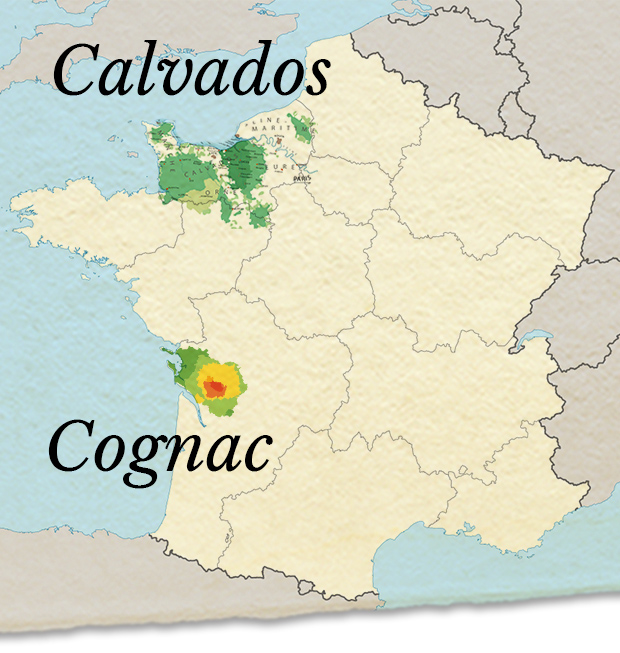
Copyright: Henrik Mattson *
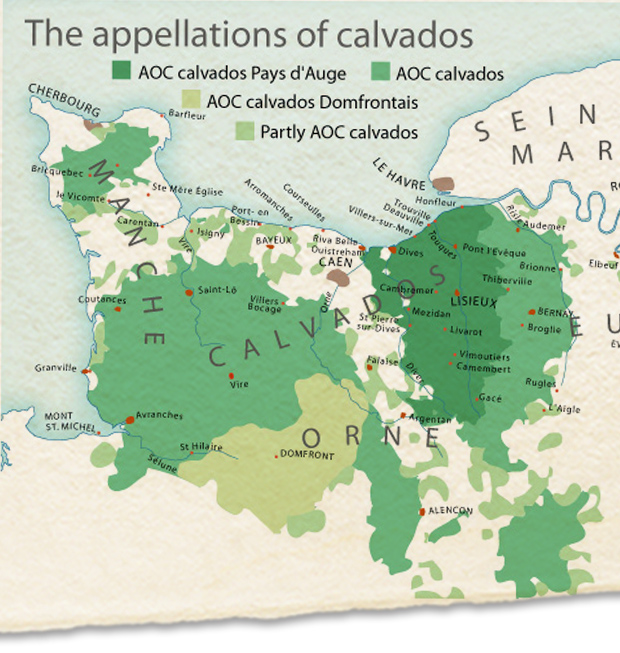
Copyright: Henrik Mattson *
In order to claim the name of Calvados, this apple-cider Brandy must strictly be produced in the department of Calvados within the Normandy region of France. Interestingly, the name for the Brandy actually came first and it was not until after the French revolution that the area received the name.
Within the Calvados department, there are three sub-regions which between them have Calvados orchards covering 7,500 hectares of land. Each of these sub-regions has its own appellation d'origine contrôlée (AOC) and set of rules by which Calvados must be produced in order to meet the requirements and bear the name. The three sub-regions are:
AOC Calvados
This sub-region stretches across the majority of the Basse-Normandie region and accounts for about 70% of the total Calvados production. The area has an oceanic climate and is characterized by relatively steady temperatures and regular, abundant rainfall.
AOC Calvados Pays d’Auge
This area surrounds the villages of Orne and Eure which are to the East of the department of Calvados. The Pays d’Auge soil is dominated by clay and calcium carbonate and this sub-region is widely recognized as producing the best Calvados of the three.
AOC Calvados Domfrontais
This sub-region covers parts of villages located predominantly in Orne, but also in Manche and Mayenne, around the city of Domfront. The soil here is damper and contains more granite, the climate is also similar to AOC Calvados, in that it is oceanic with rather stable temperatures. The Calvados Domfrontais sub-region is relatively small and only received AOC status at the end of 1997.
We will take a look at each production area’s specific rules as we continue on our exploration of Calvados.
The apples (and pears)
Calvados originates from a wide variety of cider apples and perry pears which fall into one of four flavor categories.
The apples that are suitable for making Calvados are cider apples, and they are very different from other apples such as cookers, eaters, or dessert apples. Cider apples are small in size and are particularly rich in tannins. There are over 230 different varieties of cider apple used to produce Calvados and these apples will fall into one of four flavor categories:
- Bitter varieties (which contribute to flavor)
- Tart varieties (which contribute to acidity and freshness)
- Sweet varieties (which are full of sugar to aid in fermentation)
- Bittersweet varieties (which contribute tannins)
In each of the three production areas, the orchards comprise at least 70% of bitter or bittersweet varieties, but producers will always use a blend of all four apple types to ensure a balanced and aromatic Calvados. Pears may also be used in the blend, with 139 varieties of perry pear grown in the region, however the varieties used and the ratio of apples to pears is also controlled by each individual appellation.
Within the Calvados growing region, there are two types of orchards for both apples and pears, there are orchards growing high stem trees, and those growing low stem trees.
The ‘high stem’ apple trees are the traditional trees used in Norman cultivation and these orchards have a maximum density of 280 trees per hectare with at least 5 meters of spacing required between trees. The tall varieties of trees are considered by some to produce a higher quality of apple or pear. Tall apple trees can take up to 15 years to begin cropping fruit but will then continue to do so for more than 70 years. The local proverb with regards to high stem pear trees is that they are trees that need 100 years to grow, 100 years to produce, and 100 years to die. High stem trees also allow for farmers to have cows grazing in the orchard which provides natural fertilizer and the maximum average yield for high stem orchards is 25 tonnes per hectare.
The low stem tree orchards have a density greater than 280 trees per hectare with a maximum density of 1000 trees per hectare and an average yield of 35 tonnes per hectare. These are the modern form of orchards and are for the sole purpose of fruit production. The short tree varieties mature quicker and will produce fruit at around four years old, but they require more care, attention, and fertilizer, and will only live for about 30 years.
-min.jpg)
AOC Calvados Orchards:
The orchards in this sub-region contain 230 varieties of cider apples and 130 varieties of pears and the Calvados produced here is made up of at least 35% high stem fruits.
AOC Calvados Pays d’Auge:
Here you can find 100 varieties of cider apple trees and around 30 varieties of perry pear trees. At least 45% of the fruit required for Calvados from this sub-region is grown in high-stem orchards.
AOC Calvados Domfrontais:
This sub-region is more dominated by pear trees, with at least 25% of the orchards here being planted with at least 25% pear trees of which there are 120 different varieties, whereas there are only fifty varieties of apple cider trees.
Making cider
There are two distillation methods permitted in the production of Calvados, although the method used is also dependent on the appellation.
.jpg)
The apple and pear harvest usually commences in mid-September and will continue until mid-December. The reason for the length of harvest is that the apples can only be picked at full maturity, and this requires at least three visits to each tree across the period. The fruits are harvested either by hand or mechanically, with some farmers preferring to wait until the apple has dropped from the tree to collect it. Once all the apples and pears have been harvested, they will be sorted by hand, ensuring that any damaged ones are disposed of.
The remaining apples are crushed or grated in order to produce a pulp which must then be pressed to extract the juice. Historically, pressing was done using a large stone wheel that would roll through a circular channel that held the fruits. Today, the majority of Calvados producers use the same membrane presses which are employed for winemaking, this process ensures a slow and consistent juice extraction at low pressure.
The extracted juice, or must, is then allowed to ferment, transforming it into cider and this process takes place under strict regulations. The fruit musts are left in large tanks to naturally ferment at an ambient temperature and it is forbidden for any gasification, acidification, sweetening, or pasteurization to take place. Up until 2017 it was also only permitted for the natural yeasts from the fruit’s skins to be added, but the law was then changed to allow for the use of cultivated yeasts, although most producers still only use wild yeasts.
Fermentation lasts between one and three months; during the first few days the fruit pectins will congeal and produce a solid substance that will sit on the surface of the must. This natural process is referred to as “montée du chapeau brun” and occurs as the impurities separate from the must. Gradually, the must will become clear if it is slowly and properly fermented.
During fermentation, the yeast converts all of the natural sugars found in the fruits into alcohol and produces a dry cider with a strength of at least 4.5% alc./vol. The fermentation process for AOC Calvados and AOC Calvados Pays d’Auge must last for a minimum of 21 days and 30 days for AOC Calvados Domfrontais. After this, the cider is ready for distillation.
Distillation
The magical distillation process is what transforms cider into eau-de-vie and this happens as the alcohol is separated from water.
The magical distillation process is what transforms cider into eau-de-vie and this happens as the alcohol is separated from water. When the cider is heated to a certain point, the alcohol evaporates before the water, as its boiling point is lower. The alcohol vapors are collected and condensed into eau-de-vie using a still, and it is within this eau-de-vie that all the fragrances that give Calvados its flavor are found.
It is important to know that there are two types of still that can be used for the distillation of cider into eau-de-vie and it can either be single or double-distilled, however each appellation has its own rules as to which still and method should be used. A column still is required for single distillation, whereas a Charentais copper pot still (the instrument used in Cognac distillation) is suited to double distillation.

AOC Calvados
Allows for either distillation method, however most producers single distill in a column still.
AOC Calvados Pays d’Auge:
It is compulsory that these Calvados’ are double distilled in pot stills.
AOC Calvados Domfrontais:
Must be single distilled in a column still.
Double distillation
The Charentais copper pot still required for double distillation is also the still used in Cognac production. With this instrument, the cider is poured into the boiler where it is heated up. As the alcohol steam rises, it is collected in the still head before moving on to the swan neck, and then the cooling coil which passes through a cold water basin. The contact with the cold causes the steam to condense back into liquid form. The ‘heads’ and ‘tails’ (the vapors from the beginning and end of the distillation which are rich in higher alcohols) are extracted to obtain the “brouillis” or “petite eau” which have an alcohol content of 28 to 30%.
The first distillation must be performed five or six times to obtain enough brouillis at the correct alcohol content to then be added back to the boiler for the second distillation. The brouillis is then redistilled and once again the ‘heads’ and ‘tails’ are extracted in order to retain the ‘heart’ of the distillation, referred to as “bonne chauffe” which must have an alcohol content of 72% or less when coming off the still.
.jpg)
.jpg)
Single distillation
The column still consists of three copper parts; the boiler, the distillation column which is separated into two cylindrical sections, (these are called the stripping column and concentrating column, both of which contain plates with bubbling elements that create mini chambers) and a cider heater.
Cider is poured into the top of the first column and then proceeds to descend from plate to plate via overflow outlets towards the boiler. As the cider gets closer to the boiler it heats up and as a result, the most volatile ingredients of water and esters evaporate, causing steam to be produced which then rises up the column. As the steam rises it comes into contact with the cider and is enriched with the other elements of alcohol, esters, and aromas. These vapors also migrate into the smaller column (the concentrating column) where they are condensed in the cider heater and this is where the eau-de-vie is produced at a maximum alcohol volume of 72%.
The column still features three evacuation taps that allow for the ‘heads’ and ‘tails’ to be extracted, leaving just the ‘heart’ of the distillation behind. The still can also only have a maximum flow of 250 hl of cider per 24 hours.
When it comes to the debate of which distillation process is better, there are those who argue that double distillation gives the spirit more complexity and makes it more suitable for longer aging, whereas single distillation delivers a crisp and clean apple flavor but with less complexity. The growing belief however, is that a well-operated column still can produce Calvados which is just as complex and suitable for aging as the pot still. Both distillation methods produce a clear and wonderfully fragrant eau-de-vie, ready for aging.
Aging
The time spent aging in oak barrels is what blesses the apple eaux-de-vie with its aromas and flavors.
Calvados must be aged for a minimum of 2 or 3 years in oak barrels before going to market. The minimum number of years is determined by the appellation with the regulations being a minimum of 2 years for both AOC Calvados and AOC Calvados Pays d’Auge and 3 years for AOC Calvados Domfrontais.
The process for aging Calvados is very similar to Cognac but the barrels used for Calvados are made from either Sessile or Pedunculate oak, rather that Limousin or Troncais. As the eau-de-vie sits in these wooden barrels oxygen seeps through causing natural evaporation, this results in a steady decrease in alcohol content and volume (between 2 and 4% depending on the climate) which is often referred to as the ‘angels’ share’.
It is the time spent in contact with the extremely dry oak that blesses the eau-de-vie with all the necessary elements for ideal maturation. The tannins found in the wood are what give the spirit its recognizable hue and it is the unceasing interactions between the eau-de-vie, oak, and ambient air that causes the Brandy to develop new aromas and become smoother and fuller.
There are a few different methods by which Calvados producers age their eau-de-vie. In certain distilleries, the Calvados is first aged in 250-600 liter barrels made from new, fresh oak which has a high concentration of tannins and gives the spirit considerable color and character. Following this, the eau-de-vie will then be transferred to much older barrels, which can sometimes be up to a century old. Transferring the Calvados to other barrels during the aging process can soften it and remove undesirable characteristics, as well as improve aeration.
Other producers opt to age their Calvados in previously used 1000-10,000 liter barrels straight away, these vats function as both an aging instrument and an excellent storage facility. Some Calvados distilleries also choose to give their eau-de-vie added complexity and depth by finishing off the aging in barrels that have previously contained other liquors such as Cognac, Sherry, or Port. The House of Drouin released an exquisite example of this with its ‘Hine Angels’ Calvados, a 17-year-old Pays d’Auge Calvados that spent its final six months aging in three oak barrels from the Cognac House of Hine.
Over time, the aromas of the Calvados gradually intensify and the color deepens, transforming from light gold to rich amber. Aromas of crisp apple that are distinct in the young eau-de-vie, gradually evolve to deliver more complex flavors of butter caramel, cooked apple, spices and walnut which are all characteristic of exceptional, well-aged Calvados. Some people argue that Calvados tastes surprisingly similar to Cognac after a certain age.
.jpg)
Blending and reduction
The skillful art of blending is performed by a Cellar Master in order to produce an aromatic yet balanced bottle of Calvados.
Just as is the case with Cognac, Calvados can either come as a blend or a vintage, and the blending process is performed by the Cellar Master. Cellar Masters train for decades to perfect their nose and palate in order to possess the skills required to successfully blend eau-de-vie and create a harmonious blend of Calvados.
A blend of Calvados could contain over 100 different varieties of eaux-de-vie. As we mentioned earlier, there are 230 varieties of cider apples and 139 varieties of perry pear grown in the region for the purpose of Calvados and each variety must be pressed, distilled and aged separately before blending. Calvados blends usually consist of eau-de-vie from apple and pear varieties of different terroirs and ages which when combined together produce a unique and complementary spirit.
The Cellar Master not only blends eaux-de-vie together but may also add substances such as water, caramel, sugar and Boise. Water is added to aid in the reduction of the alcohol content as despite the alcohol levels naturally falling during aging, this is often only at a rate of about 2% per year and this is usually not sufficient to reach a desirable level. Therefore, pure, distilled, or demineralized water will be added to the eau-de-vie prior to blending and this must be done progressively and in several stages.
Caramel, sugar, and Boise may be added to the blends to enhance the color and flavor. Caramel will visibly darken the Calvados, giving the impression of a more mature and better quality blend, whilst a little sugar can help produce more rounded flavors. Boise is a syrup that is also used in Cognac production and this can help to imitate a slightly more mature palate. However, the addition of these substances is strictly controlled by the appellations and can only be used in very limited quantities.
Once the eaux-de-vie has been blended, they will be allowed to mature for a few more months in the oak barrels, during which time the aromas and flavors will combine together and enrich to deliver a unified bouquet.
Not all Calvados is blended, as we briefly mentioned, there are also vintage or “millésime” Calvados’. A vintage Calvados refers to a single cask of eau-de-vie, meaning it is just one variety of apple, from a single harvest and these vintages undergo a rigorous selection process as only particularly outstanding eau-de-vie is of high enough quality to be consumed alone.
You can also find cask strength Calvados, which has not been reduced using water and is bottled at its natural strength straight from the barrel. These are often bottled on demand and offer a wonderful concentration of flavors and aromas.
.jpg)

Age classifications
Calvados can fall into a number of different age categories ranging from at least two to six years, although there are bottles of Calvados that are much older than this.
The age stated on a bottle of Calvados refers to the youngest eau-de-vie in the blend but may also contain Brandy that is much older. It is not mandatory for a bottle to state the age of the blend however when it does it must be in reference to the designated classifications. Calvados uses a similar set of age classifications to Cognac, however there are some noticeable differences:
- Fine: At least 2 years (the minimum requirement for Calvados and Pays d’Auge AOC)
- Vieux or Réserve: At least 3 years (the minimum requirement for Domfrontais)
- V.S.O.P. (Very Special Old Pale), V.O., or Vielle Réserve: At least 4 years
- X.O. (Extra Old), Napoléon, or Hors d’age: At least 6 years
- Millésime: Vintage Calvados
How to enjoy
Traditionally enjoyed as a digestif, Calvados is also now a popular ingredient in a variety of cocktails and mixed drinks.
Traditionally Calvados is enjoyed in the same manner as Cognac, after dinner and in good company, and this is particularly the case with older, superior quality Calvados. When consumed as a digestif, it is recommended to drink out of a tulip glass which has the ideal shape to emphasize the rich and varied aromas of the spirit.
Younger Calvados, such as a Fine, Vieux or VSOP, possesses dominant apple aromas that make it suitable for cocktails, mixed drinks and cooking. In fact, Calvados is an incredibly popular ingredient with mixologists to combine with liqueurs, syrups, fruit juices and spices in the trendiest bars across the world.
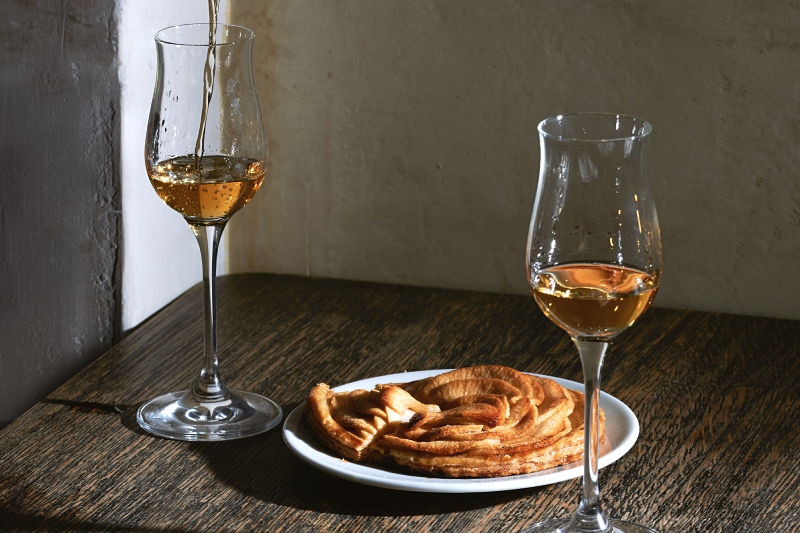
.jpg)


The Calvados House of Le Père Jules
Discover our Calvados bottles: Go to the Calvados overview page
The Calvados House of Christian Drouin
The House of Drouin is one of the leading names in the world of Calvados, with a history that stretches back three generations and an unrivaled passion for the apple Brandy, Drouin has received more than 200 gold medals over the years at international spirits competitions.
Christian Drouin Calvados first came to be in 1960 when Christian Drouin Senior acquired the Fiefs Sanite Anne estate on the Gonneville Hills. The farm already had an orchard of cider-apple trees which sparked the desire in Christian to produce his own Calvados, and so it began.
With the help of a licensed distiller by the name of Pierre Pivet, Christian spent the next 20 years distilling his cider production and allowing the eaux-de-vie to mature in pre-used casks. Drouin also obtained some particularly old Calvados due to a number of reputed producers in the region being sold.
Christain Drouin’s son joined his father in the enterprise in 1969 and together they built a brand around the production of exceptionally old and rare Calvados, a unique concept in comparison to the majority of producers who focused on young Calvados. The pair were soon selling to the world’s greatest hotels and restaurants and by 1992 they needed to relocate to a larger farm in Coudray Rabut in the appellation of Calvados.
The third generation of the Drouin’s, Guillaume Drouin, became involved in 2004 after having trained as a winemaker and agricultural engineer. Guillaume spent his first five years with the business developing exports before taking over production management and then general management in 2013. Guillaume and his father still create the blends together today and also share responsibility for the export markets. Christian Drouin Calvados is truly a family affair.
You can find a selection of Christian Drouin’s exquisite Calvados’ available to purchase on Cognac Expert here.

Christian Drouin Hine Angels Calvados
Limited Edition Finished in Hine Cognac Barrels
Finished in Cognac Barrels
Calvados age: 17 Years Old
Availability: Limited Edition
Bottle size: 700ml
ABV: 43%
Christian Drouin Hine Angels Calvados is a magnificent Calvados created in collaboration with Cognac house Hine who kindly gave Christian Drouin some of their Cognac casks to complete the aging process of this delicious Calvados offering. Having spent a staggering 17 years undergoing its maturation process, the final 6 months leave the precious eaux-de-vie to age in old Hine Cognac casks.
Aging Calvados in Cognac casks offers a unique and “experimental” method that brings out the floral flavors and silky tannins beautifully. Since this 17-year-old Calvados du Pays d’Auge already had a great depth that are in line with the flavors of Hine Cognacs, it made sense for Christian Drouin and his team to experiment with this eau-de-vie, with the use of the Hine casks for the Christian Drouin Experiment range – and it’s safe to say it certainly paid off.
As a limited special edition, only 1296 bottles are available.
Housed in a classic Calvados style bottle, Hine Angels presents a stunning deep red crest on the front of the bottle. The presentation is pulled together elegantly with matching red typography on the label work which is offset on a cream background. The design overall appears to be very traditional and reflects the well-aged liquid gold that it holds inside. A sumptuous gift to an experimental connoisseur or lover of eaux-de-vie based spirits.
Please note: This is a pre-sale. Calvados products will be shipped at the end of November (approximately)
-min.jpg)
Please note: This is a pre-sale. Calvados products will be shipped at the end of November (approximately)
Christian Drouin XO Calvados
Christian Drouin XO Calvados is produced in the Pays d'Auge from bitter, bitter-sweet, sweet and sharp cider apples by double distillation in copper stills. XO in age, it spends its maturation process in small previously-used casks, including some former wine casks. The blend also contains some sprits aged in former fortified wine casks and brandy casks, adding further sweetness and complexity to the overall finish of this stunning blend.
From fruity aromas of fresh apples to ripe apples, cooked apples, stewed apples and then dried fruit – the aromatic profile of the calvados is enhanced by floral and spicy notes taken from the wood. Meanwhile, the calvados gradually becomes smoother as the years pass by. It’s down to Christian Drouin and his son Guillaume to decide when the process is complete and the sweet liquid gold is ready for bottling.
Christian Drouin Millésime 2001 Calvados
Christian Drouin Millésime 2001 Calvados is a sumptuous Calvados from the vintage year of 2001. Having undergone a double distillation process it was then aged in old Calvados casks and former Sherry barrels where the eaux-de-vie is enriched by the wood and retains its unique character as the years go by.
The house of Drouin tells a story of passion starting in 1960 when Christian Drouin Senior became the owner of Fiefs SaintAnne on the Gonneville hills, near Honfleur. Once the farm was planted with apple trees, he acquired a hunger to produce his own calvados. For the next twenty years, he did just that going headfirst into the distillation process, before putting the eux-de-vie aside for aging. Ever since the family business has continued to blossom with Christian Drouin Junior and his son Guillaume now at the forefront of production and business management.
Christian Drouin Hors d'Age Calvados
Produced in the Pays d'Auge from bitter, bitter-sweet, sweet and sharp cider apples by double distillation in copper stills, Christian Drouin Hors d'Age Calvados is an award-winning blend that has been aged for more than fifteen years in a collection of former Calvados casks. It presents a stunning and complex example of small production artisanal Calvados - and it is a product that undoubtedly deserves all of its praise and accolades.
Dressed in a suave and sophisticated bottle, the presentation of Christian Drouin Hors d’Age is in keeping with other bottles of the brand’s collection in terms of form. This unique product, however, features metallic orange embellishments including a lions crest which appears to be symbolic of the brand’s company logo. Further orange details are seen on the neck of the bottle and typography - a design choice that completes the overall design with elegant harmony. An elegant bottle worthy of its place in even the most discerning of spirits collections.
Christian Drouin Millésime 1989 Calvados
Christian Drouin Millésime 1989 Calvados is a wonderfully well-aged calvados from the vintage year of 1989. Having undergone a double distillation process it finally finished the aging process in sherry casks where the eaux-de-vie is enriched by the wood and retains its unique character as the years go by.
Pour Calvados 1989 into the glass and allow it to sit for a few minutes as the aromas open up, then slowly sip the delicious nectar, neat at room temperature. You may want to add a few ice cubes to the glass or a drop of mineral water. Pair with a Tarte Tatin as a digestive alongside dessert. Or complete the tasting after your meal with a quality Prince Hoyo cigar.
Christian Drouin Millésime 1962 Calvados
Christian Drouin Millésime 1962 Calvados is a beautifully matured calvados from the vintage year of 1962. Having undergone a single distillation process it was then aged in old Calvados casks where the eaux-de-vie is enriched by the wood and retains its unique character as the years go by.
This well-matured calvados is best enjoyed neat at room temperature or topped up with a drop of mineral water and an ice cube. Serve as a digestive at the end of an indulgent meal and pair with a fine cigar of your choice to prolong the tasting even further.
Calvados vs. Cognac
Traditionally Calvados is enjoyed in the same manner as Cognac, after dinner and in good company, and this is particularly the case with older, superior quality Calvados
Let’s take a closer look at the similarities and differences between these two delectable spirits. Hopefully, you have now established that both of them are Brandies. Cognac, however, is a Brandy that can only be produced within the Cognac region in Southern France across six terroirs. It is also made from white grapes, primarily the Ugni Blanc grape but the Colombard and Folle Blanche can also be used, however these are the only three permitted to make up 90% of a Cognac blend, so the list of ingredients is rather restricted.
Calvados on the other hand is a Brandy that can only be made within the Calvados region across three terroirs and is made from apples or pears. The number of varieties of apples and pears used is much greater than the variety of grapes used in Cognac, with 230 varieties of apple and 139 varieties of pear available.
In order to classify as Cognac, the eaux-de-vie must be double distilled in a Charetais copper still, although the Pays d’Auge Calvados goes through this same process, Calvados from the other two terroirs is usually only single distilled in a column still.
The process of aging for both Cognac and Calvados is similar, with both spirits spending their years in oak barrels in order to develop their color and aromas. Both Brandies must also meet a minimum requirement of 2 years of aging.
When it comes to the blending, it could be argued that the process is considerably more complicated with Calvados as the Cellar Master must consider a much wider variety of eaux-de-vie for the blend. Both spirits require exceptional skill and years of experience however and the art of the Cellar Master can not be underestimated.
As with Cognac, Calvados is traditionally enjoyed as a digestif and previously carried a rather stuffy image. Yet, today both spirits have found a new lease of life and are enjoyed in a multitude of ways, including in innovative and exciting cocktails at fashionable venues around the world.
Calvados products in our shop
FAQs
Calvados is apple cider that has been distilled into Brandy. It can only be produced within three appellation designations in Normandy, France.
You may be able to purchase Calvados from your local liquor store, however why not order it from our online shop where we have a variety of products and will deliver it directly to your door?
Although traditionally enjoyed neat as a digestif, younger Calvados is also excellent in a variety of mixed drinks and cocktails. It is a popular ingredient with mixologists in bars and restaurants around the world.
Calvados is made by single or double distilling apple cider to produce eaux-de-vie which is then aged for a minimum of two years in oak barrels before being skillfully blended together and bottled.
Calvados is made from cider apples and also sometimes perry pears which have been pressed and fermented to produce apple cider. The apple cider is then distilled, aged, and blended to create Calvados.
Fine Calvados is the youngest age classification for Calvados, meaning it has been aged for a minimum of 2 years but not more than 3 years.
It is usually assumed that the older a Calvados is, the better quality it is. However, it also depends on how you will be enjoying your Calvados, as a younger bottle is best for mixed drinks and cocktails.
Yes, Calvados is gluten-free.
Yes, Calvados is apple cider that has been distilled into Brandy.
* This file is licensed under the Creative Commons Attribution-Share Alike 2.5 Generic license.
Unless otherwise specified for images: © Copyright Christian Drouin
